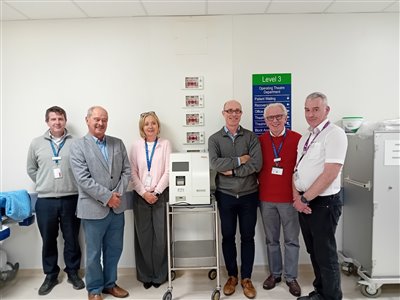ENT News
Donation of Intraoperative Parathyroid Hormone Analyser

L to R: Colm Holland Biomedical Department, John Jermyn of The Victoria Trust and member of the Board of Directors of SIVUH, Helen Donovan CEO, Prof Patrick Sheahan Consultant ENT Surgeon, Dr Richard Flynn Clinical Director, Dr Matt Murphy Consultant Endocrinologist
Parathyroid Surgery and Intraoperative PTH monitoring at SIVUH
Hyperparathyroidism is a common disorder which is characterised by excessively high levels of calcium in the blood (hypercalcaemia). It is caused by excessive secretion of parathyroid hormone (PTH), which is a hormone secreted by the parathyroid glands. The parathyroid glands are very small glands, closely related to the thyroid in the lower neck. Most people have 4 parathyroid glands. A growth (adenoma) in one or more of these glands can lead to excessive PTH secretion and hypercalcaemia. This can lead to multiple long term detrimental effects on health, including osteoporosis, fractures, kidney stones, kidney failure, heart problems, as well as symptoms of fatigue, brain fog, and general aches and pains.
Once the diagnosis of hyperparathyroidism is made, the standard treatment is surgery to remove the culprit adenoma. Parathyroid adenomas usually have a characteristic appearance that makes them recognisable at surgery, however, they can be difficult to find, as they may frequently reside in unexpected (ectopic) locations, and they tend to become displaced during enlargement. Further pitfalls are that enlarged parathyroids may have an unusual appearance, and so may be difficult to distinguish from other structures such as thyroid nodules or lymph nodes. More importantly, in 20% of cases, there may be multiple adenomas, or abnormal hypersecretion of PTH from all 4 parathyroid glands. The most important causes of surgical failure, besides not being able to find the parathyroid adenoma, are removal of something that is not a parathyroid adenoma, or failure to recognise that there is more than one adenoma or abnormally secreting parathyroid. Surgical failure is a very unfortunate outcome, as the serious underlying disorder causing health problems has not been cured, and further surgery in the future is likely to be more difficult due to scarring from the first operation, with higher risk of complications and further surgical failure.
Intraoperative PTH monitoring takes advantage of the fact that the half-life of PTH in the blood is very short, such that if the surgeon has correctly removed the culprit adenoma, the PTH levels will fall very quickly, and this can be measured while the patient is still under anaesthesia, confirming that the operation has been a success. On the other hand, if the PTH levels do not show a satisfactory drop, the surgeon continues operating until all abnormally hypersecreting parathyroid tissue has been removed. This should theoretically eliminate surgical failures due to mistaken removal of something that was not a parathyroid, or failure to recognize that there are further parathyroid adenomas that require removal. Intraoperative PTH monitoring has been considered standard of care in North America and most of Europe for over a decade, however, until recently, was not available in the South Infirmary. One of the problems is that the earlier analysers needed to be operated by laboratory technicians, sometimes situated in the laboratory, which obviated their use in the South Infirmary.
Over the last decade, the number of referrals for parathyroid surgery to the South Infirmary has increased significantly, which reflects the highly specialised nature of this kind of surgery and trend for parathyroid surgery to be centralised into the hands of high volume surgeons with appropriate expertise. An audit of surgical success rates between 2021-2024 showed a 93.2% success rate for all operations. While at first glance, this would appear very good, we felt that there was space for improvement, to minimise avoidable surgical failures, which now require more expensive imaging and more difficult revision surgery. The other major development was the availability of the NBCL analyser, which is a third generation PTH analyser. This has the major advantage that it can be kept in the operating theatre, and can be operated by a nurse or theatre technician, thus not requiring any laboratory personnel to be present. With the number of referrals for parathyroidectomy inexorably increasing, we felt that it was important that we would have a state of the art intraoperative PTH analyser available.
The NBCL analyser was acquired by SIVUH at the start of 2025, which was thanks to a very generous donation of €42,000 by the Victoria Trust. This has revolutionised our parathyroid surgery. Up to September 2025, we have performed 65 cases, with a 98.5% success rate. This is not only a significant improvement over our previous success rate of 93.2%, but also on a par with the best results in any institution in the world. Furthermore, we have been able to increase the number of parathyroid surgeries performed, and have been able to tackle the more difficult cases on our waiting list (cases with non-localised imaging or suspected multigland disease), with excellent success rates.
As we go forward, we are anticipating a further increase in the number of parathyroid surgeries performed at SIVUH. We are currently providing an expanding service for in increasing portion of Munster. Thanks to the intraoperative PTH, we are confident that we can provide world class outcomes, and that the South Infirmary can be recognised as highest volume and highest quality centre for specialised parathyroid care in Ireland.
